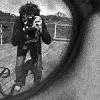Hello, I am beginning discussions with an experienced TV director who wants to step out of the TV world and into the world of small-budget, indie documentary filmmaking. He contacted me recently to get some advice on which camera he should use for his first project. He would like to do the majority of the shooting himself, but has very, very limited shooting experience. However, thanks to his lengthy exposure to television production, he has seen and been surrounded by various video technologies and has a good eye. He has around $6000 to spend on his camera, and wants to get the highest quality image possible for his doc.
So, to sum it up: he has $6000, wants high quality images, wants something that is small and lightweight, and would like to shoot much of the doc himself, even with his very limited shooting experience (probably not a good idea...)
Anybody have any advice? I was going to recommend the HVX200, as it is the camera that I have used the most that fits in his price range and, I think, would be easy (enough) for him to use. However, he will be conducting interviews and will be hindered by the p2 card's limited recording time, especially since I don't get the impression that he is tech-savvy enough to be able to download the footage to his laptop quickly and with confidence.
Does this situation strike a chord with anyone? Any thoughts?
Thanks so much,
John




